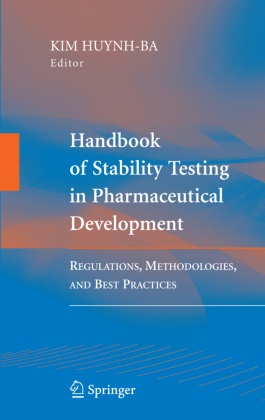Fr. 236.00
Ki Huynh-Ba, Kim Huynh-Ba
Handbook of Stability Testing in Pharmaceutical Development - Regulations, Methodologies, and Best Practices
Englisch · Fester Einband
Versand in der Regel in 2 bis 3 Wochen (Titel wird auf Bestellung gedruckt)
Beschreibung
A COMPREHENSIVE AND PRACTICAL GUIDE TO STABILITY TESTING IN PHARMACEUTICAL DEVELOPMENT
Stability testing is required to demonstrate that a pharmaceutical product meets its acceptance criteria throughout its shelf life and to gain regulatory approval for commercialization. Assessing drug product stability and safety can be quite complicated, and stability profile can impact many functional areas, including analytical testing, formulation development, toxicology, quality, and regulatory affairs.
Handbook of Stability Testing in Pharmaceutical Development: Regulations, Methodologies, and Best Practices is the first volume to cover all aspects of stability testing in pharmaceutical development. It presents a scientific understanding of regulations and balances methodologies and best practices. Comprising 17 chapters, it provides a wealth of resources for pharmaceutical companies, educational institutions, and manufacturing laboratories to use as either a supplementary text for stability training courses or as a reference book for pharmaceutical practitioners.
Topics covered include:
- Latest regulations for stability testing, including cGMP requirements, ICH guidelines, and global guidances from WHO, ASEAN, EMRO, and other regions.
- Post-approval considerations and regulatory filing strategies to support a global supply chain.
- Methodologies, including development of a stability-indicating method, method validation, and transfer. This book also discusses physical stability, non-chromatographic methodologies, and spectroscopic applications.
- Setting specifications, monitoring impurities, and establishing shelf-life of pharmaceutical products.
- Data management, including stability reports, CMC, and discussion of out-of-specification (OOS) and out-of-trend (OOT).
- USP-NF testing in support of stability.
- Current industry best practices on stability operation, validation, and calibration of stability chambers including considerations for photo-stability testing.
- Discussion of matrixing and bracketing to support reduced stability testing.
- Overview of stability programs for biologics and drug-in-devices pharmaceutical products.
This collective work was written by a group of prominent international experts, who have been directly responsible for instituting industry best practices and establishing the current stability guidelines.
Inhaltsverzeichnis
Introduction.- Critical Regulatory Requirements for a Stability Program.- Understanding ICH guidelines applicable to Stability Testing.- Global Stability Practices.- Post-Approval Changes - Stability Requirements and Regulations.- Understanding and Predicting Pharmaceutical Product Shelf-Life.- Development of Stability Indicating Methods.- Method Validation and Transfer.- Overview of USP-NF Requirements for Stability Purposes.- Non-Chromatographic Methods to Support Stability Program.- Vibrational Spectroscopic Methods for Quantitative Analysis.- Impact of Solid-State Characteristics to the Physical Stability of Drug Substance and Drug Product.- Evaluation of Stability Data.- Qualification, Calibration and Maintenance of Stability Chambers.- Stability Operation Practices.- Combination Products/Drugs in Devices.- Stability Studies for Biologics.
Über den Autor / die Autorin
Kim Huynh-Ba is Technical Director of Pharmalytik. She has over 20 years of experiences in various analytical areas of pharmaceutical development, especially in Stability Sciences. She has involved with several projects harmonizing or optimizing analytical best practices in several companies, including those are under Consent Decree. Ms. Huynh-Ba has authored numerous technical publications and book chapters. She is a frequent invited speaker at national and international conferences. She has conducted several training courses on stability compliance and quality issues for American Chemical Society, American Association of Pharmaceutical Scientists, Pharmaceutical Training Institute, Eastern Analytical Symposium since 2001. She is the founder of AAPS Stability Focus Group and actively involved with Pharmaceutical Stability Discussion Group. She is an active member of ACS, AAPS, PSDG, ASQ, POMA and serves in the Governing Board of Eastern Analytical Symposium (EAS).
In my professional career as a pharmaceutical scientist, I have been involved with several aspects of the drug development process from pre-IND to commercial and, somehow, I usually found myself coming back to a stability related issue. Stability area seems to draw my utmost interest because in my day-to-day work, my opportunities involved more than one product, and none of the issues was the same. Each situation posed challenges that usually required an exercise of judgment, an understanding of regulations, knowledge of science, a grasp of compliance, and an appreciation of common practices.
Since early 2000, I have also been involved with several training opportunities and I struggled to find good, concise, practical resources, one of which I can just hand to a new scientist who wishes to gain more understanding of stability sciences. In addition, I encountered the same questions posted over and over on different stability best practices discussion forums.
As a book lover, I also have a good collection of technical books. Unfortunately, most of the stability related books are outdated. In addition, many of these materials are theoretical and do not contain much practical information. I understand that the pharmaceutical industry during this period is quite volatile, and guidelines are changing rapidly while regulatory agencies are working closely with the pharmaceutical industry to accommodate these changes; however, the fundamental information continues to remain quite the same as current Good Manufacturing Practices (cGMP) continues to be the standard industry practice. Therefore, I hope to assemble a practical handbook to fill this void.
Zusammenfassung
This handbook is the first to cover all aspects of stability testing in pharmaceutical development. Written by a group of international experts, the book presents a scientific understanding of regulations and balances methodologies and best practices.
Produktdetails
| Mitarbeit | Ki Huynh-Ba (Herausgeber), Kim Huynh-Ba (Herausgeber) |
| Verlag | Springer, Berlin |
| Sprache | Englisch |
| Produktform | Fester Einband |
| Erschienen | 18.12.2008 |
| EAN | 9780387856261 |
| ISBN | 978-0-387-85626-1 |
| Seiten | 389 |
| Abmessung | 156 mm x 243 mm x 28 mm |
| Gewicht | 726 g |
| Illustration | XVII, 389 p. 72 illus. |
| Thema |
Naturwissenschaften, Medizin, Informatik, Technik
> Medizin
> Pharmazie
|
Kundenrezensionen
Zu diesem Artikel wurden noch keine Rezensionen verfasst. Schreibe die erste Bewertung und sei anderen Benutzern bei der Kaufentscheidung behilflich.
Schreibe eine Rezension
Top oder Flop? Schreibe deine eigene Rezension.

